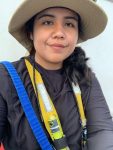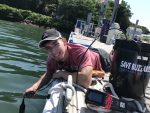Woods Hole PEP Students Get to Work on Buzzards Bay
Each summer the Buzzards Bay Coalition’s science staff grows in size with support from temporary summer field technicians and over a hundred Baywatcher citizen scientists. On top of that, this year the Coalition had two new additions to the summer science staff through the Woods Hole Partnership Education Program (PEP). PEP is a summer internship for undergraduates hosted by Woods Hole science institutions in collaboration with the University of Maryland Eastern Shore (UMES). Founded in 2009 by the Woods Hole Diversity Initiative (WHDI), PEP was created to bring diverse talent to study and work in the Woods Hole scientific community.
This was the Coalition’s first year participating in the program, working with first year PEP student, Kimberly Porras and second year PEP researcher, Hector Delgadillo. PEP co-director Onjale Scott Price welcomed this new partnership. “Our ultimate goal is for our PEP alumni to return to Woods Hole to work and conduct research, while feeling welcomed and included in the community.”
The PEP students worked with Buzzards Bay Coalition scientist mentors, Rachel Jakuba (Vice President for Bay Science), Virginia Parker (research assistant), and Alice Besterman (postdoctoral researcher), who help the students design and implement their summer research projects. At the beginning of the summer, Coalition science staff introduced Kim and Hector to the long-term monitoring of the watershed’s health, and took them in the field to see how the data was collected. Hector and Kim then developed ideas for research projects that the existing data could answer, which the Coalition mentors helped them refine and execute. “We were excited to have Kim and Hector working with us this summer. They developed research projects where they analyzed parts of our water quality and salt marsh data in ways that we haven’t previously,” said Rachel Jakuba.
Kimberly’s experience is good example of how the program melds the research needs of the Coalition with the research strengths and interests of the students, while helping to create a supportive environment for students of color in Woods Hole. A student from San Mateo Community College in California, Kimberly came to this country from Nicaragua in 2013. She is the first person in her family to get any kind of formal education.

Kimberly Porras
Working with the Coalition this summer, Kimberly compared the data collected by Baywatchers volunteers with data collected by automated Data Loggers. Her analysis showed that the volunteer and logger data are consistent with each other. The automated loggers collect data around the clock, while volunteers only collect a sample about every five days. Kim was curious about the benefits of volunteer sampling beyond providing accurate data. Kim developed and sent out a survey to current Baywatchers that 61 of them completed. The overwhelming majority (92%) said that being a Baywatcher had an impact on their understanding of the local environment. A majority (73%) also are very interested in the monitoring results and check how the Bay Health Index score changes each year.
This is Hector Delgadillo’s second summer in the PEP program. Last year, due to COVID restrictions, he worked remotely with Woodwell Climate Research Center. This year as part of Buzzards Bay Coalition’s research team, he analyzed previously collected data about the species composition of salt marshes in the Buzzards Bay watershed. Hector hails from California’s Central Valley, so his salt marsh research has been eye-opening. Hector studied the two dominant salt marsh grass species at the Coalition’s 12 long-term monitoring sites. He found that in general, there was the expected pattern of Spartina alterniflora (smooth cordgrass) growing at low elevations and Spartina patens (salt marsh hay) growing at higher elevations. There were a few sites where the two species overlapped, which peaked Hector’s interest. He observed that these results produced more research questions – Is the overlap driven by sea level rise? Are both species abundant where they overlap or is it just a few stems of one species?

Hector Delgadillo
Hector has high praise for his Coalition mentors. “They believe in me and were always available. They helped me create my research project, hone my skills, and they gave me confidence in my ability to work with people and my peers. I’ve also learned not to be afraid to ask questions.” Hector appreciates how the program has taught him valuable career skills like networking with colleagues, how to write an abstract, or how to write a résumé. The PEP program culminated in mid-August with a symposium for which both Hector and Kim developed scientific presentations with help from their mentors. At the symposium the PEP interns presented their research to their peers and members of the Woods Hole scientific community.